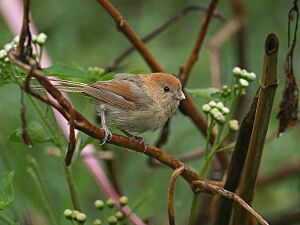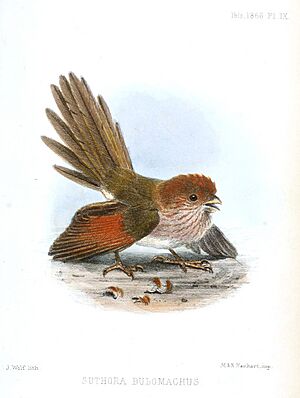Vinous-throated parrotbill facts for kids
Quick facts for kids Vinous-throated parrotbill |
|
|---|---|
 |
|
| S. w. bulomachus, Taiwan | |
| Conservation status | |
| Scientific classification | |
| Genus: |
Suthora
|
| Species: |
webbiana
|
| Synonyms | |
|
Sinosuthora webbiana |
|
The vinous-throated parrotbill (Suthora webbiana) is a small bird with a long tail. It is part of the Paradoxornithidae family. You can find these birds in many parts of Asia, including China, Japan, Korea, Mongolia, Russia, Taiwan, and Vietnam. They like to live in moist mountain forests in warm or tropical areas.
How Scientists Name Birds

The vinous-throated parrotbill was first described in 1852 by a scientist named John Gould. He placed it in a group called Suthora. Over time, scientists changed their minds about which group this bird belonged to. It was moved to Paradoxornis, but new studies using DNA showed that this group needed to be split up.
Now, many scientists think the vinous-throated parrotbill should be in the group Sinosuthora. However, the International Ornithologists' Union (a big bird expert group) has put it back into its original group, Suthora. This bird is very similar to the ashy-throated parrotbill. Sometimes, these two types of parrotbills even have babies together where their homes overlap.
The bird's scientific name, webbiana, honors an English plant expert named Philip Barker Webb. Because of this, the bird is sometimes called Webb's parrotbill.
Where Do They Live?
The vinous-throated parrotbill lives in a wide area, from northern Vietnam all the way to southern Manchuria. They can live in many different kinds of places. They often prefer open wooded areas, like bushes, young forests, or the edges of older forests. You might also find them in thickets, bamboo patches, hedges, reeds, and marshes.
These birds are also good at living in places changed by humans, such as tea plantations and plant nurseries. In China, they live in lower mountain areas. In Taiwan, where it's the only type of parrotbill, it lives from sea level up to very high mountains (about 3,100 meters or 10,000 feet). This shows how adaptable they are!
What Do They Look Like?
The vinous-throated parrotbill is a fairly small bird with a long tail. It is usually about 11 to 12.5 centimeters (4.3 to 4.9 inches) long. Males weigh about 8.5 to 11 grams (0.3 to 0.4 ounces), and females weigh 7 to 12 grams (0.2 to 0.4 ounces). Like other parrotbills, their beak is short, and their nostrils are hidden by small feathers.
Both male and female birds look very similar. Their upper body is a warm brown color. Their wings are dark brown, with a hint of reddish-brown on the flight feathers. The upper part of their chest and throat are a pinkish-cream color, with brown streaks on the throat. Their sides are similar to their back but a bit lighter, and their belly is a creamy-yellow color. The top of their head and forehead are reddish-brown. They have pale gray eyes and a beak that is slate gray or brown, often with a lighter or yellow tip.
How Do They Act?
Like other parrotbills, these birds are very social. They almost always live in groups, or flocks. The size of these groups changes throughout the year. They are smallest during the time when birds are laying eggs and raising young. In winter, these groups can grow very large, sometimes with as many as 140 birds!
Scientists in Taiwan studied these winter flocks. They found that birds in a flock could be grouped into four types:
- Core members: These birds always stayed with their flock.
- Regular members: They mostly stayed with their flock but sometimes visited other groups.
- Floaters: These birds moved around a lot between different flocks.
- Peripheral members: These birds were only seen for a short time and were likely just visiting from other areas.
Even when large winter flocks are close to other groups, they usually stay together.


